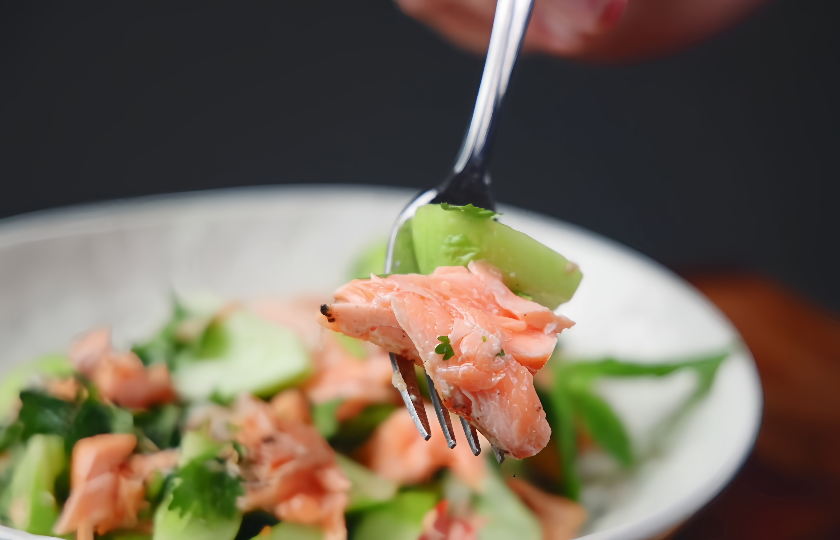Salmon Salad Cilantro Dressing Recipe
The classic pairing for salmon salad is cilantro dressing, a fresh sauce that complements the rich flavor of the fish and the refreshing taste of the salad perfectly.

 2 Comments
2 Comments
Required Ingredients
Salmon: Provides a rich, delicious flavor and serves as the core of the dish.
Onion: Adds fragrance and a slight sweetness to enhance the flavor of the salmon.
Cilantro: Brings a refreshing aroma, adding depth to the dish.
Cucumber: Offers a crisp, refreshing texture that balances the richness of the salmon.
Sea Salt: Elevates the overall taste, used for seasoning.
Black Pepper: Adds a mild spiciness to enhance the flavor.
Olive Oil: Used for pan-searing the salmon, contributing to a fragrant and tender texture.
Fish Sauce: The base of Thai-style dressing, providing a unique salty and umami flavor.
Lime Juice: Adds acidity, making the dish more refreshing.
Honey: Adds sweetness to the dressing, balancing the sour and salty flavors.

Types of Salmon to Buy
Wild-Caught Salmon: This type comes from natural waters, and its flesh is typically darker with a more intense flavor. It has a lower fat content, making it firmer and suitable for those who enjoy a fresh, somewhat "wild" taste. When used in salads, its flavor stands out, but it is relatively more expensive.
Farmed Salmon: The most common type in the market, farmed salmon has a tender texture and higher fat content, making it ideal for dishes that require retaining the oil, such as pan-searing or baking. Its flavor is softer, and it is usually more affordable than wild-caught salmon.
Alaskan Salmon: Also wild-caught, this salmon comes from the cold waters of Alaska. Its flesh is firmer, and the flavor is incredibly fresh. If you prefer a more natural, pure seafood taste, Alaskan salmon is a great choice.
Atlantic Salmon: Typically farmed, this salmon is very soft with rich fat content, making it perfect for sushi, sashimi, or other raw dishes. If you plan to serve it raw or lightly cooked, this type is ideal.
Skin-On/Boneless: If you want to keep the crispy skin of the salmon, choose skin-on salmon. When pan-seared, the skin becomes crispy and adds a delicious flavor. Boneless salmon is more suitable for making salads or other dishes where a smoother texture is desired.
Common Mistakes to Avoid
Overcooking the Salmon: When pan-searing salmon, don’t cook it for too long, especially if you like it medium-rare. 4-5 minutes is usually enough. Overcooking will result in dry, tough fish, losing its tender texture.
Not Balancing the Sauce: The fish sauce, lime juice, and honey in the Thai dressing should be balanced to achieve the right mix of sour, sweet, and salty flavors. If the taste isn’t quite right, adjust the fish sauce or honey slightly, but avoid adding too much salt to prevent it from becoming too salty.
Not Crispy Skin: If you’re using skin-on salmon, make sure to cook it skin-side down until crispy. The skin is a delicious part, so don’t waste it by failing to crisp it up!
Chopping the Vegetables Too Coarsely: Vegetables like onions, cilantro, and cucumber should be cut into small pieces or thin slices to enhance the salad’s texture. Larger chunks can affect the overall mouthfeel, so cutting them properly will make the salad easier to mix and enjoy each bite.
Not Mixing the Dressing and Vegetables in Time: The dressing and vegetables need to be mixed quickly, especially after tearing the salmon into pieces. While it’s still warm, stir everything together to ensure the sauce is evenly coated on every ingredient.
INGREDIENTS
MAIN INGREDIENTS
- 200g salmon
ACCESSORIES
- 50g onion
- 30g cilantro
- 1 cucumber
SEASONINGS
- 5g sea salt
- 3g black pepper
- 30ml olive oil
- 2 tbsp fish sauce
- Half a lime lime juice
- 1 tbsp honey
DIRECTIONS
STEP 1
Place the 2 pieces of cleaned salmon on a cutting board.

STEP 2
Season the salmon with sea salt, black pepper, and olive oil, making sure to coat it evenly.

STEP 3
Prepare the onion, cilantro, and cucumber, and set them aside.

STEP 4
Make the Thai sauce: Mash the chili and garlic, then mix in the sea salt, black pepper, 2 tablespoons of fish sauce, lime juice from half a lime, and 1 tablespoon of honey. Add a little water and stir well.

STEP 5
Heat a pan, add olive oil, and cook the salmon on medium heat until both sides are golden and slightly undercooked (about 4-5 minutes).

STEP 6
Let the cooked salmon cool, then tear it into pieces.

STEP 7
Mix the prepared vegetables (onion pieces, cilantro sprigs, cucumber slices) with the salmon, pour in the Thai sauce, and gently toss to combine.

STEP 8
Garnish with two mint leaves for a refreshing aroma. Done!

More recipes worth trying
Refreshing Chicken Salad: A Light Favorite!
cold tossed wood ear mushrooms
Crispy Air Fryer Chicken Salad
Storage and Preparation in Advance
This salmon salad is perfect for preparing in advance, and you can enjoy it either cold or hot. Just store the cooked salmon in a sealed container and place it in the fridge, where it will stay fresh for up to two days.
On the second day, you can enjoy it straight out of the fridge or heat it up—either way, it's still delicious. In fact, leftovers often have more flavor than freshly made dishes, as all the seasonings and ingredients have had time to meld together, resulting in a richer taste.
If you want to eat it hot, simply warm the salmon, but be careful not to overheat it to avoid drying it out. Pair it with some salad or rice, and it will still taste great. For a cold option, just mix everything together—refreshing and tasty!
How to Enjoy Salmon Salad
As a Sandwich
Pile the salmon salad on your favorite bread for a simple and hearty meal. You can choose whole grain bread, French baguette, or toasted burger buns, and pair it with some lettuce and cherry tomatoes for a fantastic taste.
Lettuce Wrap
For a lighter option, try wrapping the salmon salad in lettuce leaves like romaine or butter lettuce. It’s a healthy, low-calorie choice that’s especially refreshing with every bite.
With a Veggie Salad
If you prefer more vegetables, pairing salmon salad with a simple veggie salad (like arugula, spinach, or lettuce) is a great match—refreshing and nutritious.
With Crackers as a Snack
Eating salmon salad with crackers is also fun, especially when paired with ranch crackers. The crispy texture of the crackers complements the rich flavor of the salmon salad, making it a perfect afternoon snack.
With Grains
To make the meal more filling, serve the salmon salad on top of steamed couscous, quinoa, or lemon rice. It adds texture and depth to the dish. Moroccan-style couscous is especially delicious and pairs wonderfully with the salmon salad.
Recipe analyzer
- Recipes: Salmon Salad Cilantro Dressing Recipe
- Main Ingredients:4
- Servings per recipe:1
- Servings size:481 g
-
Energy (calories):357 kcal
-
Protein:43.63 g
-
Fat:14.87 g
Why gray?

-
Carbohydrates:10.11 g
-
Protein: 52%184 kcal
-
Fat: 38%134 kcal
-
Carbohydrates: 11%39 kcal

The ratio shows whether the proportion of both fatty acids in your diet is optimal. Red color means too much of Omega 6 or too little of Omega 3. The data are rounded off and approximate.







2 REVIEWS